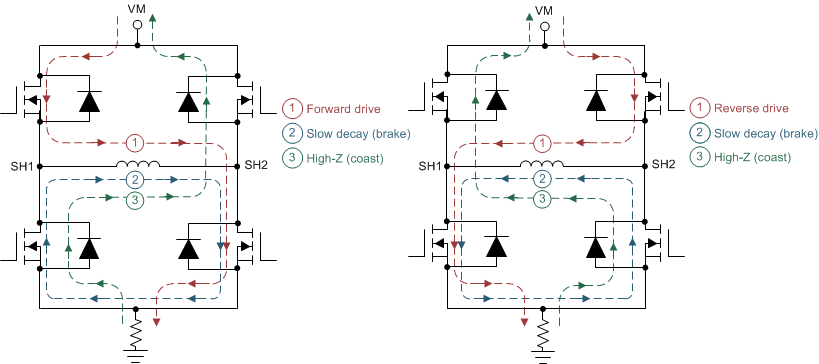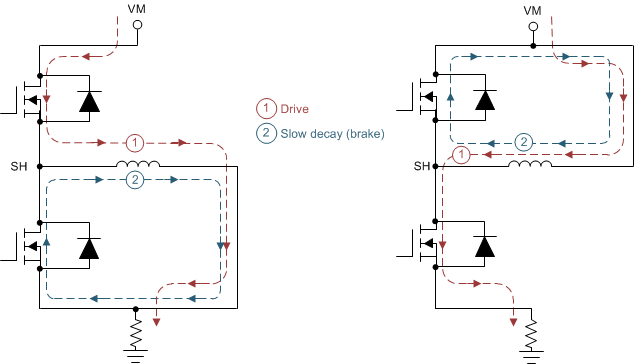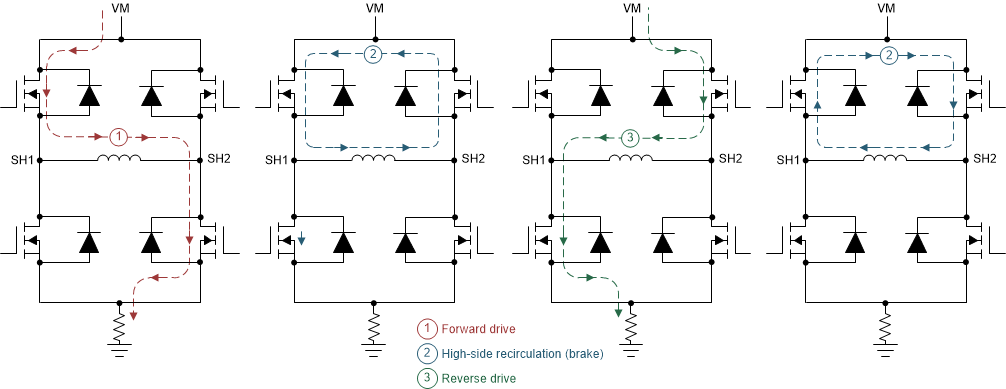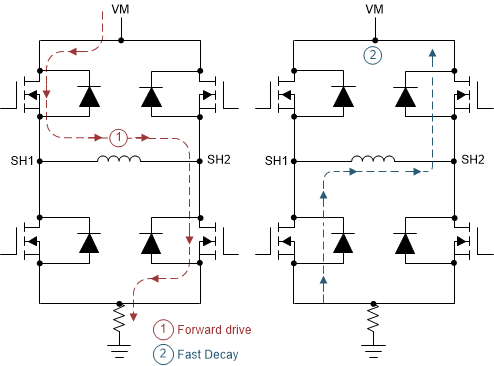SLVAE59A February 2019 – April 2022 DRV8242-Q1 , DRV8243-Q1 , DRV8244-Q1 , DRV8245-Q1 , DRV8343-Q1 , DRV8702-Q1 , DRV8702D-Q1 , DRV8703-Q1 , DRV8703D-Q1 , DRV8803 , DRV8804 , DRV8805 , DRV8806 , DRV8860 , DRV8873 , DRV8873-Q1 , DRV8874 , DRV8874-Q1 , DRV8876 , DRV8876-Q1 , DRV8935 , DRV8955
2.2 Half-Bridge and H-Bridge Driver Configurations
The half-bridge driver uses two MOSFETs to control the current through a solenoid; one MOSFET to forward drive the solenoid and the other to recirculate current.
The H-bridge driver uses four MOSFETs, or two half-bridges joined by a load, to control current through a solenoid. With four MOSFETs, bidirectional current control is possible. This makes H-bridge drivers a good choice for single-coil and latching or dual-coil relays.
The H-bridge and half-bridge configurations can be seen in Figure 2-4 and Figure 2-5.
 Figure 2-4 H-Bridge Drive and
Recirculation Current Paths
Figure 2-4 H-Bridge Drive and
Recirculation Current Paths Figure 2-5 Half-Bridge Drive and
Recirculation Current Paths
Figure 2-5 Half-Bridge Drive and
Recirculation Current PathsWhile the half-bridge can only enable slow decay, the half-bridge integrates the freewheeling diode, which is typically an external component. This further reduces the solution size. There is also the benefit of flexibility between driving high- or low-side loads with the half-bridge.
The H-bridge driver can enable both slow and fast decay (coast) by recirculating current with either high- or low-side MOSFETs. Figure 2-6 shows how an H-Bridge can be utilized to drive a conventional solenoid valve with high-side recirculation.
 Figure 2-6 H-Bridge Configuration
Utilized to Drive a Solenoid Valve
Figure 2-6 H-Bridge Configuration
Utilized to Drive a Solenoid ValveAn H-Bridge can also be used as an effective fast discharge circuit. Fast decay can be accomplished by turning off the MOSFETs and allowing current to flow through the body diodes. This results in an opposing voltage to the solenoid current equal to VM plus the forward voltage of the two body diodes. Figure 2-7 shows current flow for fast decay with H-Bridge.
 Figure 2-7 H-Bridge Fast Decay
Figure 2-7 H-Bridge Fast DecayIf fast decay and improved system thermal performance are desirable, an H-Bridge configuration could be a good fit.